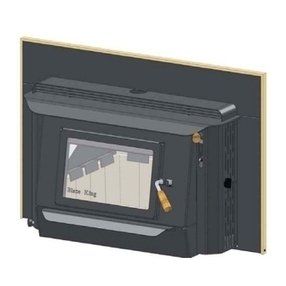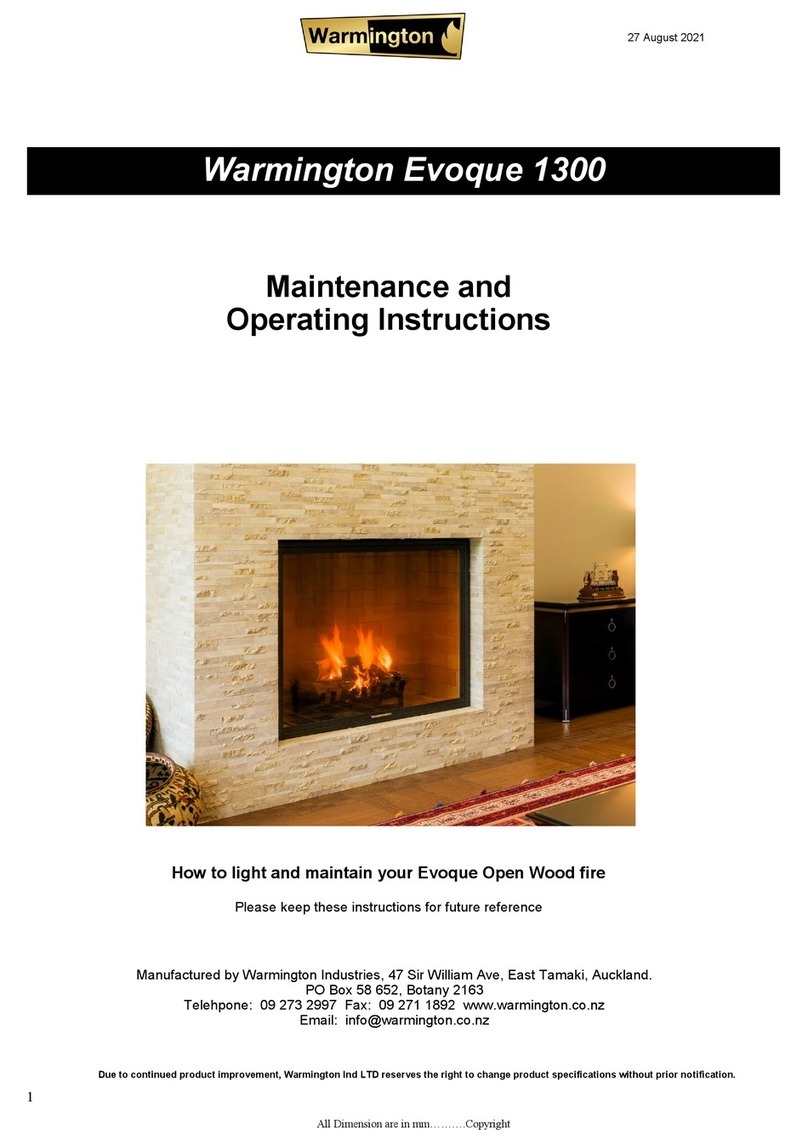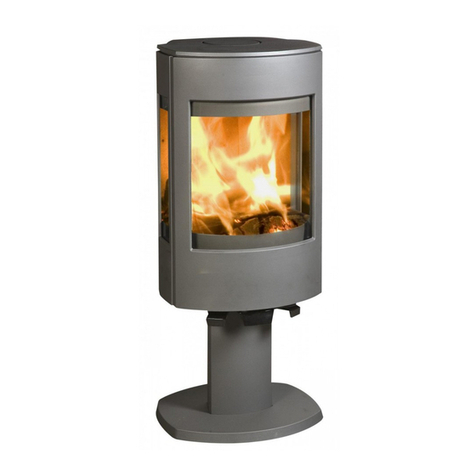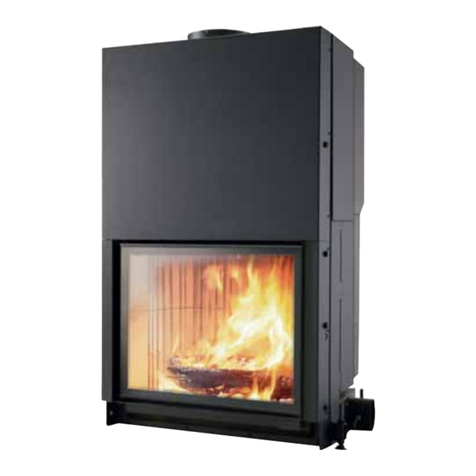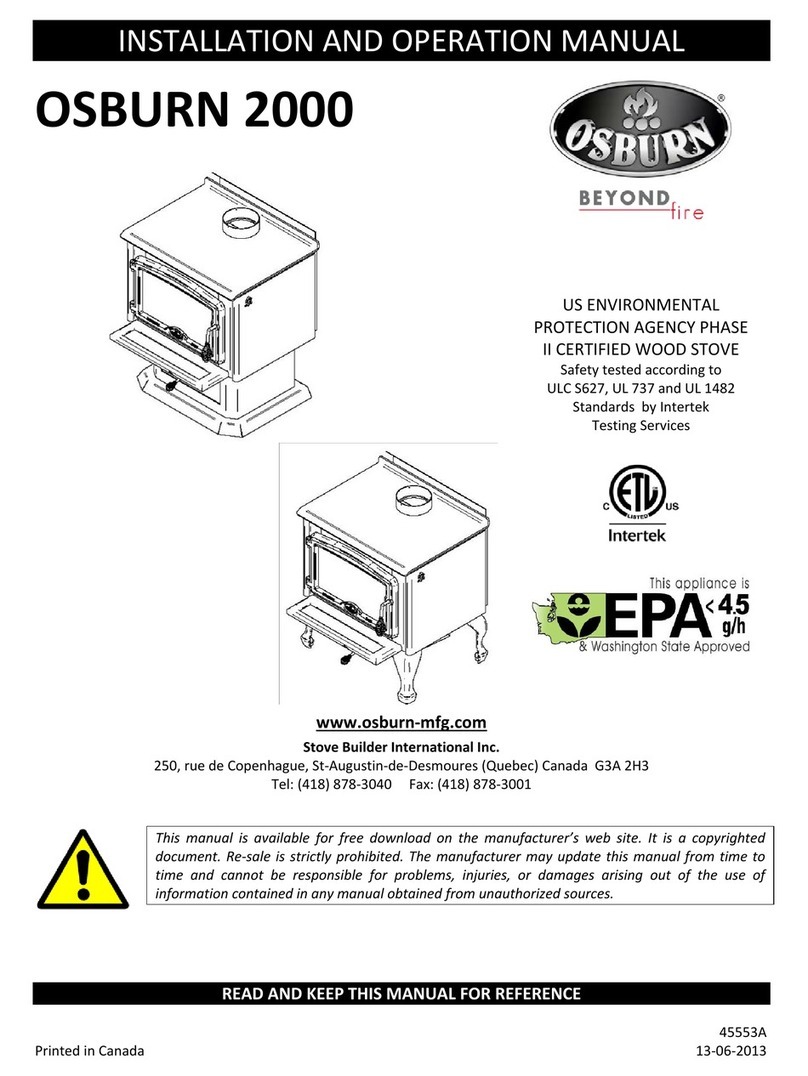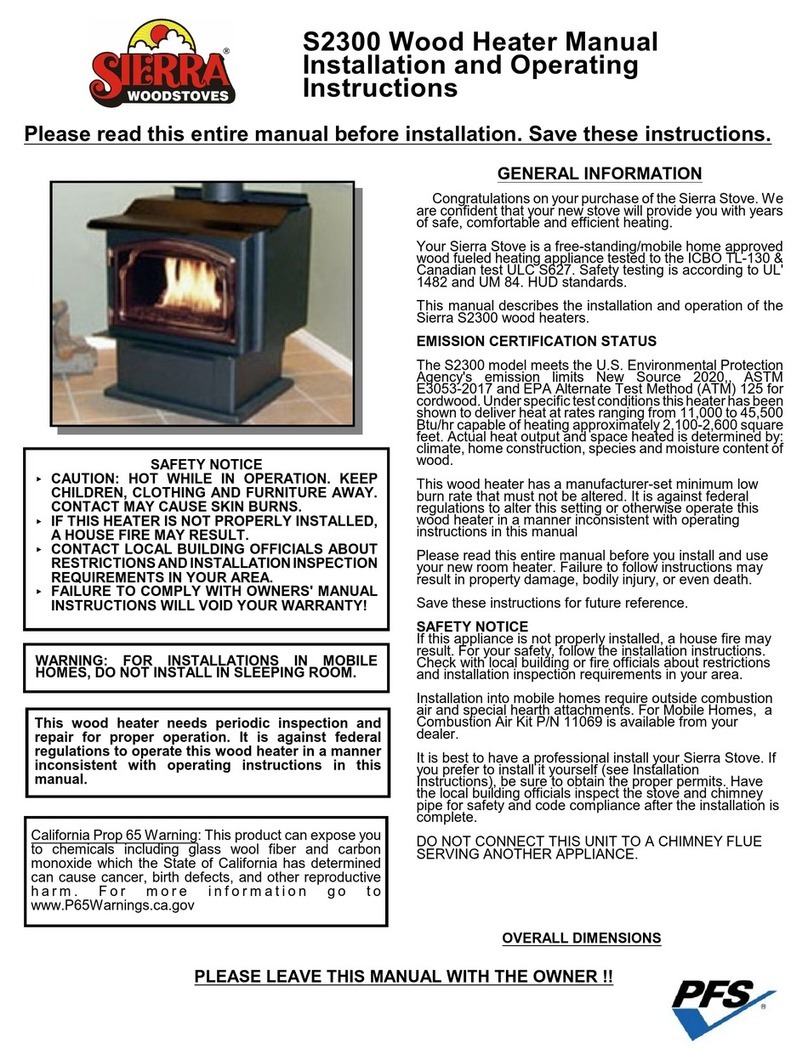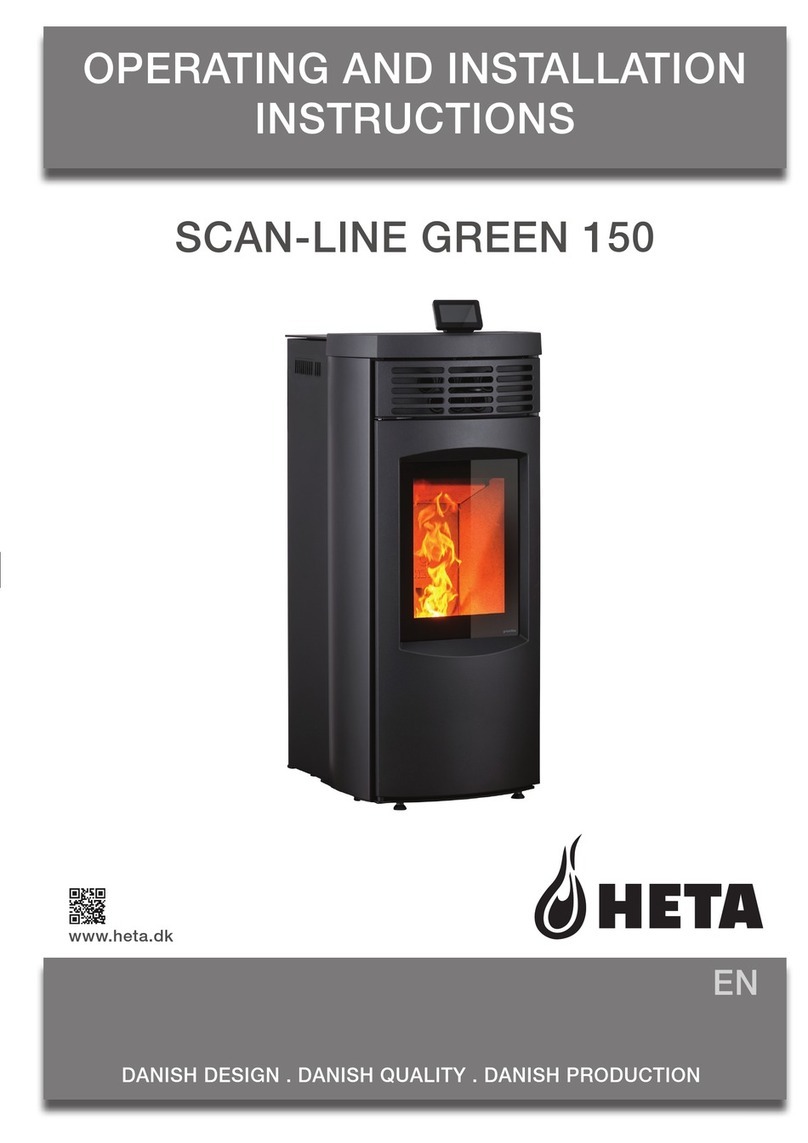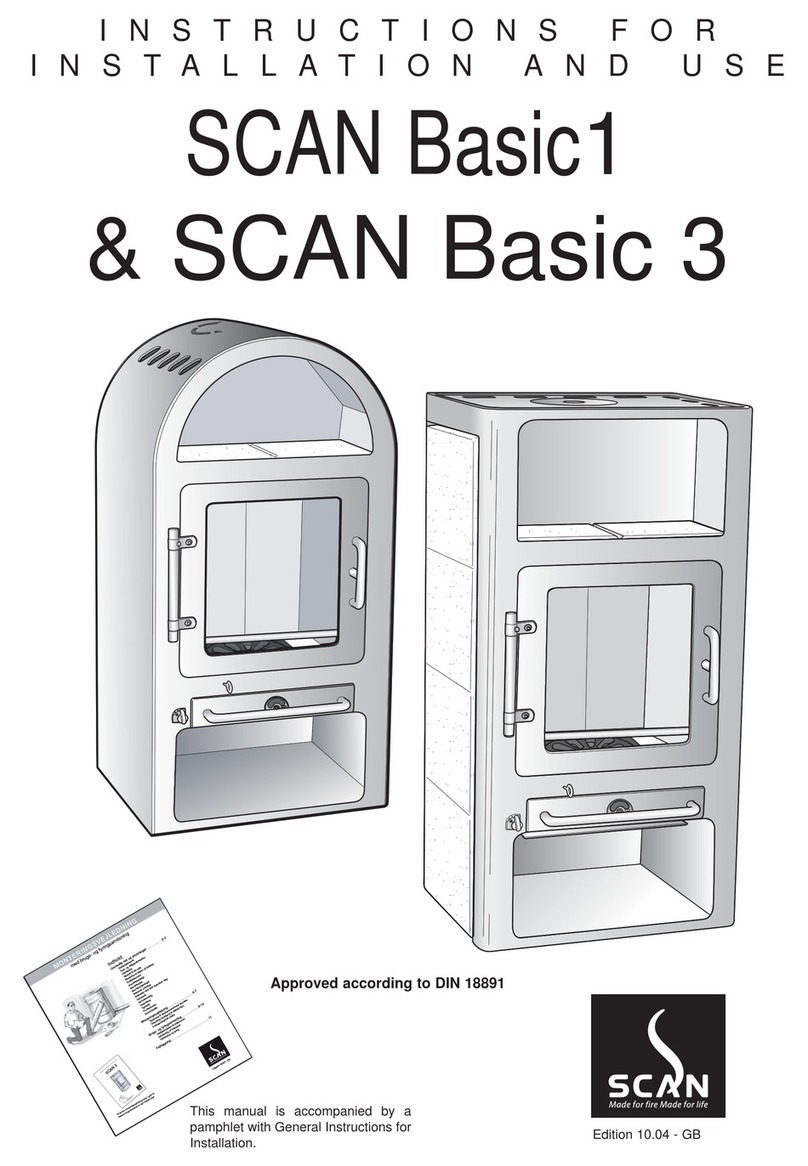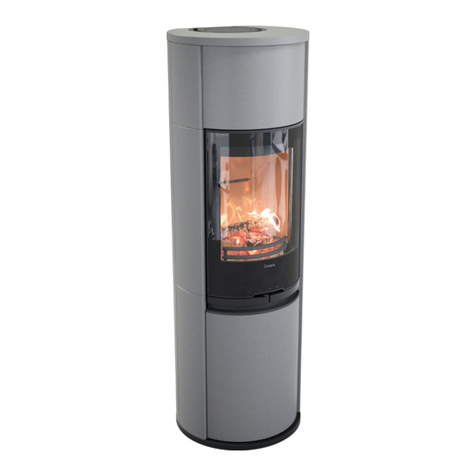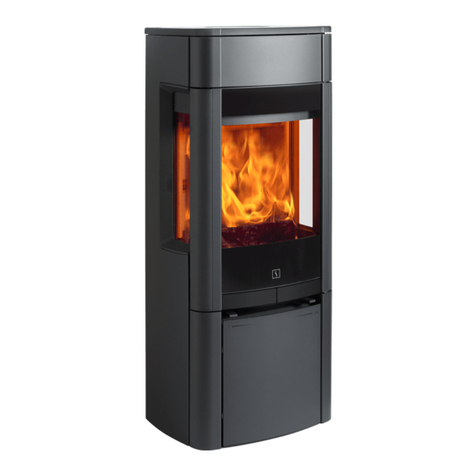
until the desired burn rate is achieved. Be careful to retain
a flame as this will produce clean combustion, clean glass
and highest efficiencies.
6. When ashes get 4 to 5 inches deep in the firebox, and
when the fire has burned down and cooled, remove excess
ashes. Leave about an inch of ash in the bottom of the
firebox to help maintain a hot charcoal bed.
Maintaining Catalytic Conditions -During the start-up of
a cold stove, a medium stove, a medium to high air setting
must be maintained for about 20 minutes. This ensures
that the stove, catalyst, fuel, and chimney area all at proper
operating temperature. Even though it is possible to have
smoke temperature reach 600 degrees within two or three
minutes after af ire is started, the combustor and the
chimney are not yet warm enough. At the end of the burn
cycle; it’s possible that the amount of buring charcoal
mightnot provide sufficient temperatures for the catalyst.
During the refueling, we recommend that the stove be fired
hard for at least 10 minutes to ensure that the satalyst and
chimney are properly warmed up. If you have a long or
large diameter chimney, or if it is very cold outside, run the
stove on high for a longer period.
Whenever loading the stove, KEEP THE BYPASS OPEN!
NEVER remove the combustors to clean them. If there
seems to be excessive fly ash on the combustors, use the
blower side of your vacuum claener to blow ash out. Be
cerain you never vacuum ash into your vacuum cleaner.
Always replace the mixers after brushing the combustors.
Combustor Life and Replacement - Sierra uses only
“12,000 Hour Long Life Combustors.” The combustor will
still be functioning at 7-% of its effectiveness after 12,000
hours of use. Depending on the frequency of stove use, it
will last for four to twelve years before needing
replacement.
OVERNIGHT BURNING
To hold a fire overnight, load the firebox with a full supply
of wood which has a minimum diameter of six inches.
Wood still in "the round" will burn longer than split wood.
After experimenting with the slide draft for a few days, you
will discover the correct setting for your home. If the fire is
out in the morning and wood is burned up, open the slide
draft a little more the next night.
MORE FUEL AND OPERATION TIPS
Fuel Sizes: S8000II uses 17" to 19" wood side to side. The
ideal fuel load is about 24 lbs. Producing about 17,000 to
72,600 Btu/Hr.
"Hard" wood (oak, maple, ash, nut trees, etc.) is better for
overnight burning than "soft" wood (fir, cedar, pine, spruce,
etc.)
PLAN AHEAD: PUT IN NEXT YEAR'S WOOD NOW!
Creosote Formation and the Need For Removal
Unseasoned or wet wood contains large amounts of
moisture. When this wood is heated in the fire, the water is
vaporized and driven off as steam at about 212 to 300
degrees Fahrenheit. As the temperature of the wood
reaches 300-600 degrees Fahrenheit the flammable liquid
in the wood fiber cells is vaporized and it too is driven off
as a steamy smoke.
If the temperature is high enough and there is a sufficient
amount of oxygen present, the steamy flammable wood
gases will ignite and burn. The burning of these gases is
what is referred to as "secondary combustion" and appears
as the rolling orange flame above the wood.
When there is an insufficient amount of either heat or
oxygen present in the stove, this wet and steamy smoke
does not ignite and burn. Instead it is drawn through the
exhaust vent and into the chimney. As this steam begins to
cool down in the flue it condenses as droplets of moisture
on the inside walls of the chimney. This becomes creosote
which is flammable and is the fuel which burns in a flue
fire. It is necessary to periodically clean these deposits
from your stove pipe and chimney.
Creosote deposits are dangerous and are deemed a
flue fire waiting to happen!
Visually check your chimney monthly. If creosote
deposits are more than 1/4" thick, remove them.
VII. CATALYTIC INSPECTION AND REPLACEMENT
It is important to periodically monitor the operation of the
catalytic combustors to ensure they are functioning
properly and to determine when they need to be replaced.
A non-functioning combustor will result in a loss of heating
efficiency, and an increase in creosote and emissions.
• The combustors should be visually inspected at least
three times during the heting seson to determine if
physical degradation has occurred. Remove the catalytic
cassette by loosing the two 3/8" nuts. Look for cracks,
cell blockage, excessive fly ash and general
deterioration.
You can get an indication of whether the catalyst is working
by comparing the amount of smoke leaving the chimney.
1. Leaving the bypass open, go outside and observe the
amount of smoke leaving the chimney.
2. Close the bypass, go outside and observe the amount of
smoke leaving the chimney.
Significantly more smoke should be seen when the
bypass is open and the exhaust is not being routed
through the combustors. Be careful not to confuse
smoke with steam from wet wood.
After inspecting the combustors and it it determined that
they are defective, they must be replaced. Read the
catalytic warranty information carefully.
3. Inspect the bypass gasket regularly. A bright light or
flashlight is useful for locating any areas that are not
sealed.
MAINTENANCE
The following tips on maintenance will help you keep the
Sierra Stove performing in an attractive and efficient
manner.
CHIMNEYS AND CREOSOTE
Formation and Need for Removal - Creosote is one of the
facts of life for wood burners. When wood is burned slowly,
it produces tar and other organic vapor which combines with
expelled moisture (even “dry” wood contains approximately
20% moisture) to form creosote. The creosote vapors
condense in the relatively cool chimney connectors and flue
of a slow-burning fire. As a result, creosote residue
accumulates on the flue lining. Large amounts of this tough,
gummy, tar-like substance can pile up quickly and virtually
choke a stove pipe. When ignited, this creosote makes an
extremely hot and dangerous fire.
Be sure to examine the chimney connector pipe and the
chimney above it every few weeks so you can determine
the rate of creosote build up.
Any excessive build up of creosote (more than 1/4")
will then be apparent and
must be removed for continued safe operation.
The chimney must be inspected from the top of the
chimney. For a thorough cleaning and inspection, your
SIERRA woodstove should be removed from the hearth.
If creosote has accumulated, it should be removed to
reduce the risk of a chimney fire. Creosote formations can
be chipped away from flue openings with a sturdy metal
blade such as a heavy duty scraper.
CAUTION: The acid content can cause burns to skin
and eyes, so wear protective glasses and gloves.
13
















